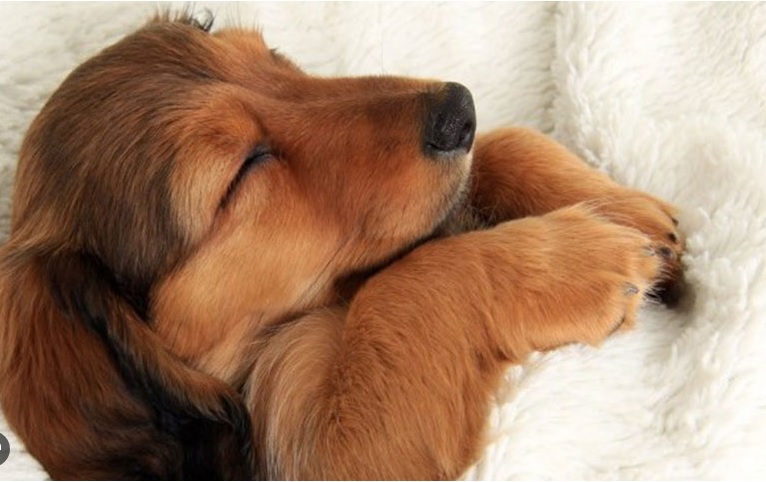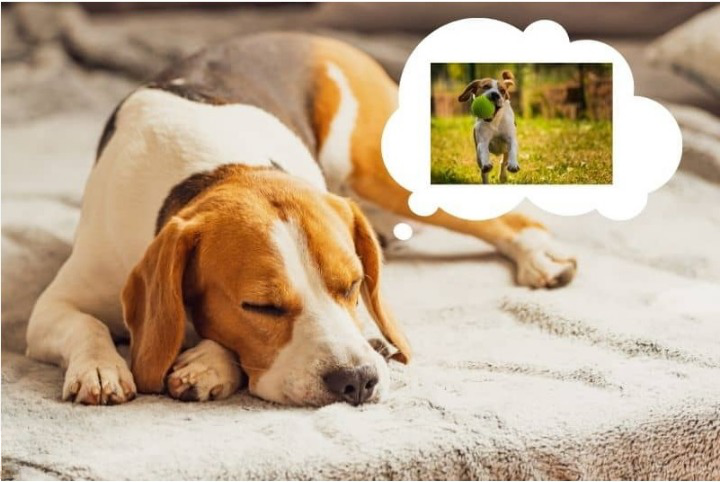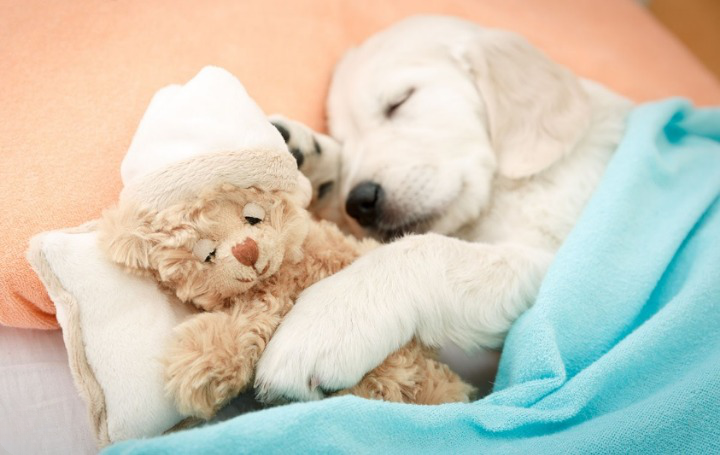Do dogs dream? It’s a question that has surely crossed your mind as you watch your furry friend twitch and whimper in their sleep. Well, prepare to be amazed because the answer is a resounding yes! Dogs do indeed dream, just like we do.

This article delves into the fascinating world of dog dreams. We’ll explore the science behind them, discuss signs that indicate dogs are dreaming, and even uncover whether our beloved pets can have nightmares.
So get ready to embark on a journey into the secret realm of doggy dreams – it’s bound to leave you feeling grateful for the great companionship your furry friend provides.
Dogs Dream Key Takeaways
- Dogs dream during REM sleep.
- Dogs’ sleep patterns vary depending on breed and age.
- Inadequate rest can make dogs irritable and affect their learning ability.
- Dogs can have nightmares, which can be reduced by providing a comfortable sleep environment.
The Sleep Patterns of Dogs Dream
Dogs’ sleep patterns include periods of REM (rapid eye movement) where they dream. It’s fascinating to think about what goes on inside their furry little heads while they sleep. Just like humans, dogs need quality sleep for their overall well-being. Sleep is crucial for them to recharge and recover from daily activities.
Dog sleep patterns can vary depending on the breed and age of the dog. Puppies, for example, tend to sleep more than older dogs because their bodies are still growing and developing. Older dogs may also require more rest due to age-related factors.

Ensuring your canine companion gets enough sleep is essential for their health and happiness. Dogs who don’t get adequate rest can become irritable or have difficulty learning new things. So ensure your pup has a comfortable sleeping area and establish a consistent bedtime routine.
Remember, understanding dog sleep patterns and recognizing the importance of sleep for dogs will help you better care for your furry friend’s needs.
The Science Behind Dog Dreams
During REM sleep, which is the stage when dogs are most likely to dream, their brains show increased activity similar to that of humans. This suggests that dogs experience dreams just like we do.
Scientists have theorized that dog dreams may involve experiences, memories from their waking lives, instinctual behaviors, and desires.
Brain Activity During REM Sleep
Unfortunately, you can’t experience engaging brain activity during REM sleep like dogs. During this stage of sleep, your furry friend’s brain becomes highly active, similar to when awake.
It’s during REM sleep that dogs are believed to dream.
Here are three interesting facts about the brain activity of dogs during REM sleep:
Understanding the science behind dog dreams can help us better care for our beloved pets and ensure they get the quality sleep they need.
Similarities to Human Dreams
Just like humans, you can also experience dreams similar to those of dogs during REM sleep. Dream recall and dream interpretation play a significant role in understanding the similarities between human and canine dreams.

While humans can vividly recall their dreams upon waking up, dogs may struggle with remembering their plans due to differences in brain structure. However, studies have shown that dogs exhibit similar brain activity patterns during REM sleep as humans do when they dream.
This suggests that they, too, engage in complex mental processes and experience visual imagery during this stage of sleep.
Although we may not fully understand the content or meaning of a dog’s dream, it is clear that they can dream just like us. So next time you see your furry friend twitching or whimpering during sleep, remember that they might be experiencing their version of a dream!
Theories on Dream Content
Regarding theories on dogs dream content, you might wonder if there’s a hidden message in your furry friend’s sleep adventures. Some dog owners believe that dogs dream and their dreams are similar to human goals. They theorize that dogs may experience dream symbolism and have the ability to understand the meaning behind their dreams.
While no scientific evidence supports these theories, many people find comfort in thinking that their beloved pets can have meaningful dream experiences. Understanding dream symbolism in dogs can be intriguing for those who want to serve their pets’ needs and desires.
So next time you see your pup twitching or making little noises while sleeping, remember that they could embark on an exciting adventure in their dreams, just like humans do.
Signs That Dogs Are Dreaming
Amazingly, our furry friends often display unmistakable signs that they’re deep in a dream. It’s truly fascinating to witness! You may notice your dog twitching paws, wagging their tail, or whimpering while sleeping. These signs are clear indicators that they’re dreaming away.

But what exactly do dogs dream about? Like humans, dog dream interpretation can vary from one puppy to another. Some common dream themes for dogs include chasing squirrels or balls, playing with their favorite toys, or even reenacting events from their day. It’s almost as if they’re reliving all the fun and excitement in their sleep!
So next time you catch your furry friend in a deep slumber, know they’re experiencing their adventurous dreamscape.
Do Dogs Have Nightmares?
Imagine your pup lying peacefully in their bed, but as they drift deeper into sleep, you can’t help but wonder if they ever experience disturbing nightmares. Just like humans, dogs can have bad dreams too. The impact of the sleep environment on dog nightmares is significant. Providing a comfortable and safe space for your furry friend to sleep can help reduce the likelihood of them having nightmares. A cozy bed and a quiet room free from distractions are essential. Additionally, there is a strong relationship between anxiety and dog nightmares.

Dogs suffering from anxiety during waking hours are likelier to experience disturbing dreams while asleep. Ensuring that your pup’s anxiety is properly managed through training, exercise, and possibly medication can greatly decrease the occurrence of nightmarish episodes during their slumber.
Taking these steps will improve your dog’s sleep quality and contribute to their overall well-being by providing them with peaceful and worry-free nights.
The Benefits of Dog Dreams
One of the perks of a dog’s slumber is that they can ‘let sleeping dogs lie’ and enjoy the benefits of their dreams. Dog dreams are adorable to watch and serve important functions for our furry friends. Here are three ways in which dog dreams benefit them:
So next time you see your furry companion twitching or wagging its tail while asleep, remember that they’re enjoying these incredible benefits of dreaming!
Interpreting Dog Dreams
While catching a glimpse of your furry companion’s tail wagging or twitching during sleep, you may find yourself intrigued by the fascinating world of interpreting their dreams.
Interpreting dog dreams can provide valuable insight into their emotions and overall well-being. Like humans, dogs experience various emotions in their dreams, such as happiness, fear, or sadness. Attention to their body language and vocalizations during sleep can give clues about their plans.
Additionally, dream recall in dogs is possible through cues like whimpers or barks upon waking up. Understanding and interpreting these signals can help you better understand your canine friend’s inner world and provide them with the love and care they need.
So next time you see those tail twitches, remember that your loyal companion might be living out an exciting adventure in dreamland!
Factors That Influence Dogs Dreams
Age and development, breed and genetics, daily experiences, and stimulation are all important factors influencing your dog’s dreams.
As your dog ages, their dreams may change as their brain develops and matures.
Different breeds just like the smartest dog breeds may also have different dream patterns based on their genetic predispositions.
Additionally, the daily experiences and stimulation your dog receives can shape the content of their dreams.
Age and Development
As dogs grow and mature, their dreams become vivid movies playing in their sleeping minds. Like humans, age plays a significant role in the frequency and content of dog dreams. Puppies, for example, have more frequent dream cycles than adult dogs. This could be because they are experiencing rapid brain development during this stage. Their dreams may contain simple images and scenarios as they navigate different developmental stages.
To understand how age affects dog dreams, let’s take a look at the following table:
Understanding these stages can help us better serve our furry friends by providing them with appropriate care and comfort during their dreams.
Breed and Genetics
When considering breed and genetics, you’ll be amazed by how a dog’s unique genetic makeup can influence the depth and complexity of its slumbering thoughts.
Dogs dream like humans, but their dreams may vary depending on breed variations and genetic factors.
Different breeds have different traits and characteristics, affecting what they dream about during sleep. For example, a hunting breed may dream about chasing prey or running in an open field, while a herding breed may dream about rounding up sheep.
A dog’s genetics also play a role in their dreams, as certain genetic factors can predispose them to dream more vividly or frequently.
So next time you see your furry friend twitching in their sleep, remember that their breed and genetics are contributing to the fascinating world inside their dreaming mind.
Daily Experiences and Stimulation
Throughout your dog’s waking hours, the daily experiences and stimulation they encounter greatly shape their slumbering thoughts.
Just like humans, dogs dream during their sleep. Dog dream interpretation is a fascinating field that can shed light on what goes on in their minds while they sleep.

By understanding your dog’s daily experiences and providing them with positive stimulation, you can help improve their sleep quality and overall well-being. Ensuring they have plenty of exercise, playtime, and social interaction throughout the day can contribute to more peaceful dreams at night.
Creating a comfortable sleeping environment for your furry friends, such as a cozy bed or designated sleeping area, can also enhance their sleep experience.
Remember, by enriching your dog’s daily life, you’re serving them and contributing to their happiness and restful dreaming.
Enhancing Your Dog’s Dream Experiences
Adding soothing music and a cozy blanket to your dog’s sleeping area can enhance their dream experiences, making them feel like they’re floating on a cloud of tranquility.
Creating a peaceful environment for your furry friend promotes relaxation and enhances sleep quality.
Here are some dream recall techniques that can further enhance their experience:
Remember, prioritizing your dog’s sleep and dream experiences creates an atmosphere of love and care for them.
Fun Facts About Dog Dreams
Get ready to be amazed by some fascinating tidbits about the dreams of our beloved furry companions. Fun facts about dog dreams will surely bring a smile to your face!
Did you know that dogs have similar sleep patterns to humans? Like us, they experience rapid eye movement (REM) and non-REM sleep. During REM sleep, when most dreaming occurs, their brains are highly active, and their bodies may twitch or even make adorable little noises. You might notice them wagging their tails or running in their sleep – they’re probably chasing squirrels or playing fetch in dreamland!
Dogs also tend to dream about things that happen during their waking hours, like familiar scents and sounds. So next time you see your pup snoozing away, remember they’re having sweet dreams like we do!
Understanding and Appreciating Your Dog’s Dreaming Experience
As you reflect on the captivating world of your furry companion’s slumber, imagine yourself embarking on a whimsical journey through their dream-filled wonderland. It’s truly remarkable to think about the emotions dogs experience in their dreams and how their sleep patterns contribute to this fascinating phenomenon.
Interpreting dog emotions can be challenging, but by observing their behavior during sleep and understanding canine sleep patterns, we can gain valuable insights into their inner world. Dogs often exhibit twitching, wagging tails, and soft barks while dreaming, which suggests they’re reliving joyful experiences or chasing imaginary friends. Conversely, they may also whimper or make distressed sounds when having a nightmare.
By appreciating your dog’s dreaming experience and providing them with a safe and comfortable sleeping environment, you’re actively serving them in ways that promote their overall well-being and happiness.
Frequently Asked Questions
How long do dogs typically dream for?
Dogs typically dream for about 20 minutes during their sleep patterns. Dreaming is believed to play a crucial role in memory consolidation, helping dogs process and remember information from their daily experiences.
Can dogs dream about their owners or other familiar faces?
Dogs can dream about their owners or other familiar faces. They may see you in their dreams just like you see them in yours. While dogs may not remember their goals, they still hold a special place for you in their subconscious mind. As the saying goes, “A dog is a man’s best friend.”
Do all dogs dream, or are they only certain breeds?
All dogs, regardless of breed, can dream. They can have nightmares just like humans, and their dreams are believed to be in color. Dogs’ dreaming patterns are similar to ours.
Are puppies more likely to have vivid dreams than older dogs?
Yes, puppies are more likely to have vivid dreams than older dogs. This is because they spend much of their sleep in REM sleep when dreaming occurs.
Can dogs have recurring dreams or dream series, similar to humans?
Dogs can have recurring dreams or dream series, just like humans. Dream patterns in dogs can impact their behavior, affecting their interactions with others. Understanding and addressing these dreams can help serve your dog’s well-being.
CONCLUSION
Dogs do indeed dream, just like humans. During REM sleep, their brains show increased activity similar to ours. Signs of dreaming include twitching paws, wagging tails, and whimpering. Quality sleep is crucial for their well-being, affecting their happiness, learning, and health.
Providing a comfortable sleep environment and managing anxiety can reduce nightmares. Understanding and caring for their sleep and dreams enhances their overall happiness and bond with us.
Donate to Bonevoyagedogrescue and help us continue our work saving dogs in need.
